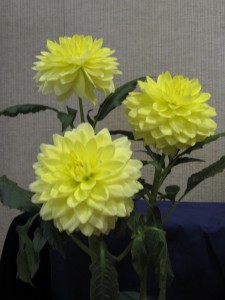According to the American Dahlia Society there are 18 classes of dahlias, from the popular small flowered dahlietta types to the large flowered dinner plate type. Dahlias hail from South of the Border, down Mexico Way, and are not reliably winter hardy north of USDA zone 7-b.
Dahlias are easy to grow. They want a compost rich well-drained soil. Hot summers, lots of natural rainfall, and a constant nutrition yield strong tall plants full of bouquets of colorful flowers. Feed dahlias monthly from planting time through August with a water soluble fertilizer such as Miracle Gro®, Schultz®, or Hollytone®. Follow the package directions.
Dahlias are tubers and are planted them as you would seed potatoes. Tubers may be purchased at garden centers from early spring through mid-June here in the Southern Appalachian region (USDA hardiness zones 6 and 7). After the frost danger has passed in your area, plant dahlias in a sunny garden spot or in a large container filled with an organic soil-less potting media.
Dahlias require a minimum of half to full day sunlight. Give plants room to grow and add a 4-6 foot tall stake to support the large flowering types when blooming. Flowers tend to flop and the plant breaks apart over when soaked by heavy rain.
Tuber(s) are spaced 18-24 inches apart and set to a 4-6 inches depth in rich, well-prepared garden soil. Place the tuber on its side with the eyes (growth buds) facing up. As the dahlia shoot(s) grow taller, fill the hole with one inch of soil every 7-10 days until even with the ground surface. Summer heat and plentiful soil moisture promises great blooming dahlias. If needed, irrigate early in the day and keep water off the dahlia foliage.
Overwatering will cause root rots and a likely invasion of slugs on the foliage. Dahlias are also susceptible to Japanese beetles which shatter the flowers. Deer generally do not bother dahlias.
Dahlias bloom prolifically right up to frost. The plant will collapse (die above ground) and you will need to dig up the tender tubers and store them away through the winter months.


 Posted in
Posted in 
